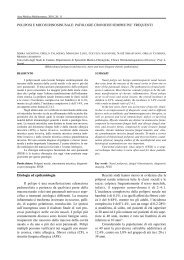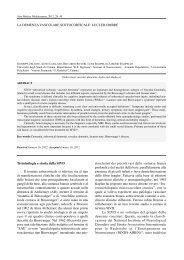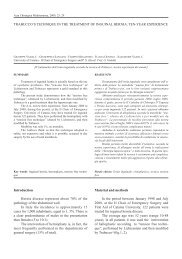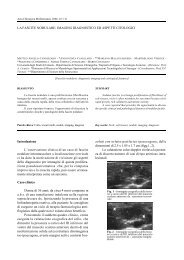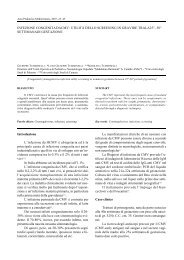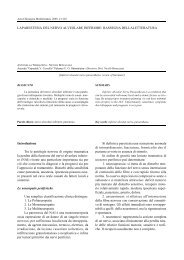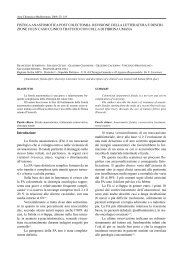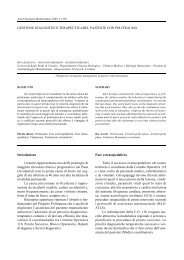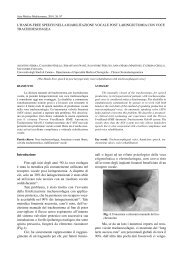RESPONSE TO ANAESTHETIC DRUGS IN ... - Carbone Editore
RESPONSE TO ANAESTHETIC DRUGS IN ... - Carbone Editore
RESPONSE TO ANAESTHETIC DRUGS IN ... - Carbone Editore
You also want an ePaper? Increase the reach of your titles
YUMPU automatically turns print PDFs into web optimized ePapers that Google loves.
Response to anaesthetic drugs in myasthenia patients 49<br />
on neuromuscular transmission while phenothiazines<br />
appear to interfere with neuromuscular transmission<br />
as a result of postsynaptic desensitization.<br />
All halogenated anaesthetic agents can depress the<br />
function of the tractor units muscles. This effect can<br />
be significant and occur at several levels: central<br />
depressant effects, stabilizing effect of the membrane<br />
with a decrease in membrane conductance of<br />
calcium channels and above all depressant effects<br />
on the functioning of the postsynaptic membrane.<br />
They do not seem to have a direct action on ach<br />
receptors. In practice, they determine a depolarizing<br />
block, with a more pronounced effect in the case of<br />
halothane rather than enflorano or the isofluorane.<br />
In healthy subjects they allow for a decrease<br />
of 25% to 50% in the need for curare, while in<br />
myasthenia patients they often determine an acceptable<br />
muscle relaxant for the duration of surgery. If<br />
nitrous oxide has no documented effect on neuromuscular<br />
transmission and can be used in such<br />
patients without any precaution, isofluorane reduces<br />
T1 and train of four, T1 on T4 relationship with<br />
an effect of muscle relaxant two times higher than<br />
halothane.<br />
Enflorano instead can lead to muscle relaxant<br />
with varying and heavily dependent on the severity<br />
of myasthenia. Sevofluorane 2.5% suppresses the<br />
electromyographic response to T1/Tc with 47% and<br />
T4/T1 at 57% so much so that it has been used in<br />
some cases of thymectomies by transternale both as<br />
vapour and as a muscle relaxant anaesthetic. In normal<br />
patients undergoing anaesthesia with desflorane<br />
the curare request is reduced, and this gas due to<br />
its low solubility and its subsequent rapid washout<br />
may have interesting implications in myasthenia,<br />
both for muscle relaxant properties that would<br />
allow for the surgical procedure without the addition<br />
of curare, and for the rapid elimination.<br />
Local anaesthetics act as agents for rapid ion<br />
channel blockers, suppressing the propagation of<br />
nervous transmission, the release of Ach, the sensitivity<br />
of the postsynaptic membrane and the exciting<br />
of muscle cell. Local anaesthetics also increase<br />
neuromuscular blockade of all no depolarizing<br />
curari and seem able to decrease neuromuscular<br />
transmission in myasthenia gravis. Loco-regional or<br />
local anaesthesia should be practiced using smaller<br />
doses of local “amid” anaesthetics with the<br />
“Estereo” group (procaine, tetracaine), already<br />
widely out of use, should not be used in myasthenia<br />
treated with anticholinesterases as they are metabolized<br />
by plasma cholinesterase, with an increase in<br />
the rate of serum and with it toxic effects. The<br />
blocking of the nerves of the intercostals is not<br />
advised due to deficiency of respiratory dynamics,<br />
and recently there have been reports of epidural<br />
anaesthesia in thymectomies by trasternale.<br />
Discussion<br />
The considerable progress in anaesthesia, in<br />
recent years has allowed for the use of new drugs<br />
such as propofol, mivacurium, cisatracurium, sevorane,<br />
desfluorane and remifenatanil, due to their<br />
easy handling and reduced side effects allow for the<br />
execution of a balanced anaesthesia or a TIVA<br />
without risks in myasthenia patients.<br />
Volatile anaesthetics and curare with longer<br />
half-life make the approach even more secure in<br />
myasthenia patients. Studies previously mentioned<br />
and the experience gained in the field led to the<br />
embrace of surgery such as the attitude of “Miniinvasive<br />
Anaesthesiology”or rather minimal<br />
“Pharmacological Aggression” in patients with<br />
myasthenia. Current guidance is designed to favour<br />
recently introduced drugs such as propofol and<br />
remifentanil, intravenous anaesthesia (TIVA) in<br />
accordance with the more recent method of infusion<br />
(TCI site effect or plasma concentration), the<br />
desfluorane or sevorane if the choice is to use a<br />
balanced anaesthesia.<br />
These drugs are united by the following common<br />
properties; easy handling, a rapid wash-in, low<br />
half-life, and therefore rapid wash-out with fast elimination<br />
and minimal side effects.<br />
References<br />
1) Abel M, Eisenkraft JB. Anesthetic Implication of<br />
Myasthenia Gravis. The mountsinai journal of medicine<br />
January/March 2002: 32-36.<br />
2) Jaretzki A III, Barohn R J, Ernstoff R M. Myasthenia<br />
gravis: Recommendations for clinical research standards.<br />
Neurology Vol 55 (1), 12 July 2000: 16-23.<br />
3) Kawamata M, Miyabe M, Nakae Y, et al. Contunuous<br />
thoracic epidural blockade in combination with general<br />
anaesthesia with nitrous oxide, oxygen, and<br />
sevoflurane in two patients with myasthenia gravis.<br />
Masui 1993; 42: 898-901.<br />
4) Leventhal S R, Orkin F K, Hirsh R A. Prediction of the<br />
need for post-operative mechanical ventilation in<br />
myasthenia gravis. Anestesiology, 1980, 53: 26-30.



